Philips 55OLED807 Review
The light fantastic with Philips mid-range OLED
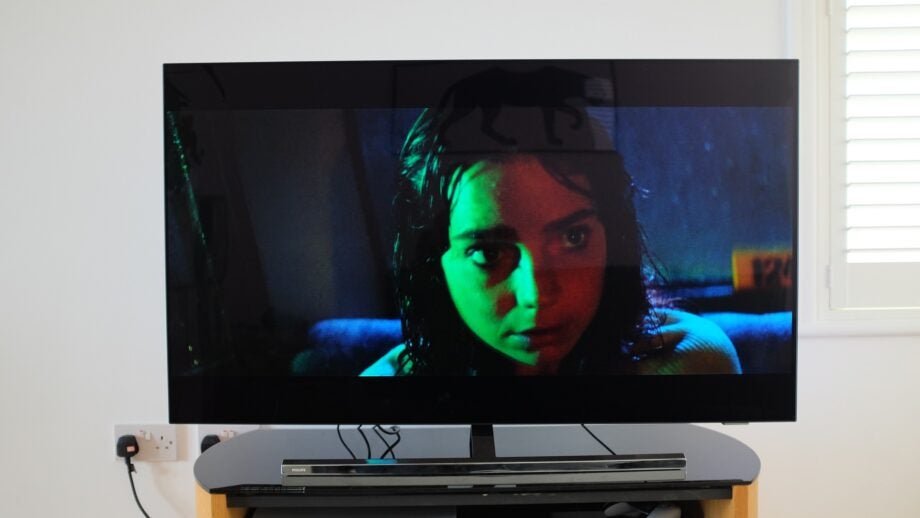

Verdict
If any questions still remained, the OLED807 answers them: Philips can deliver a high-performance mid-price TV to compete with the best of them
Pros
- Great build, finish and spec for the money
- Formidable picture performance across the board
- Ambilight never fails to impress
Cons
- Meandering set-up menus
- Android TV is ‘good’ rather than ‘great’
- Can sound slightly confused at the top end
Key Features
- HDRAll worthwhile HDR standards supported
- AmbilightFour-sided Ambilight
- Smart OSAndroid TV interface
- OLED technology‘EX’ OLED panel
Introduction
Safe to say Philips is on something of a roll with its televisions lately. Last year’s OLED806 rapidly became something of a performance-per-pound hero – so naturally Philips, with the launch of the OLED807, is hoping lightning will strike twice.
On paper the OLED807 looks the part. As well as the 55-inch version I’m testing here, it’s available in 48, 65 and 77-inch screen sizes – and it’s very competitively priced at every stage. Its specification is on the money, and it’s got that special Philips USP too… so let’s get it off the paper and onto the bench, and find out exactly what’s what.
Availability
- UKRRP: £1499
- USAunavailable
- Canadaunavailable
- Australiaunavailable
The Philips 55OLED807 is on sale now, and in the United Kingdom it sells for £1499, maximum. Philips (or, rather, parent company TP Vision) has been umm-ing and ahh-ing for quite some time about whether or not its TVs should be offered for sale in the United States – and as of right now it seems the OLED807 isn’t going to make the journey. It’s a similar story in Australia, too.
This, there’s no denying, is bad news for our American and Australian friends. Here’s why…
Design
- screen swivels on its stand
- slim and not slim all at once
- properly built and finished
Philips (like almost every TV brand, to be fair) understands what we consumers want from the design of their nice new television: screen, and plenty of it. So the OLED807 features four winningly narrow bezels, the brevity of which are only emphasised by the hefty, shiny T-bar stand the screen rests on. There’s a good amount of swivel available from the stand, too, so little changes of orientation no longer require lifting the whole device up.
There’s some cable-management at the rear of the chassis thanks to a clip-on/clip-off panel that covers all the physical inputs apart from mains power.
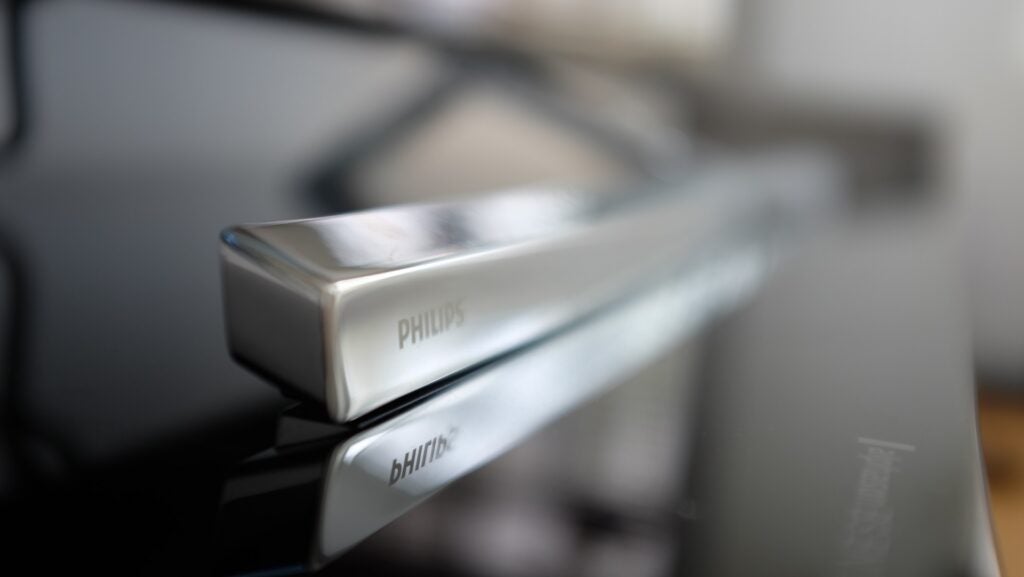
In profile, there’s a portion of that lovely OLED slimness we all covet, but below there the OLED807 is an unglamorous 68mm deep. At least Philips has compelling mitigation as to why that might be, though…
Throughout, build quality is unarguable. Given the asking price, it’s no surprise to find a lot of plastic used in the 807’s construction, and in places it’s quite hard, ordinary-feeling plastic too. But everything is screwed together properly, nothing groans or creaks, and the way the stand has been chromed is flawless. For the money, it’s hard to know what else you can realistically expect.
Features
- All HDR standards available
- Extensive smart TV offering, even more extensive set-up menus
- Good connectivity includes HDMI 2.1
The 55OLED807 is quite similar to competing TVs from alternative brands in many ways – so I may as well start with the feature that puts the Philips out on its own: Ambilight.
It’s been around for a fair while now, but for the uninitiated: Ambilight is a series of LEDs arranged in strips around the rear of the TV’s chassis. For the 807, all four sides of the bulkier portion of the rear of the screen feature a line of LEDs – they can be switched on or off by the user, and if they’re on the user can decide if the light they deliver should follow the on-screen colours or remain constant.
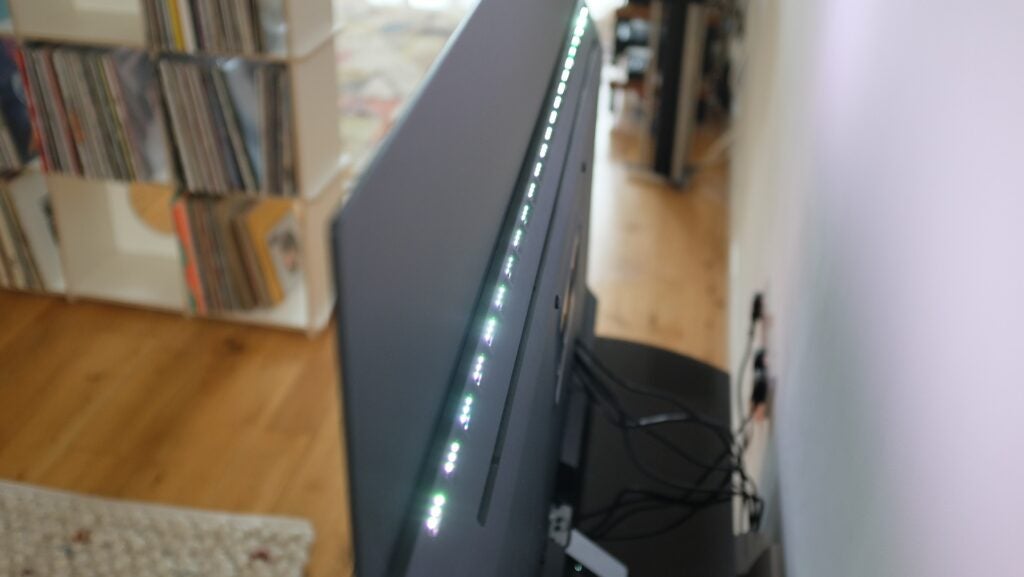
Ask them to follow the on-screen hues and they create a coloured glow around the edges of the screen on the wall behind it – it makes the image seem larger than it already is, and also reduces eye-strain.
When you see it written down it can’t help but seem gimmicky. See it in action, though, and you’ll quickly realise it’s a brilliantly worthwhile feature – so much so that I can only imagine the Philips patent must be absolutely watertight, because otherwise every other TV brand would feature something very similar too.
So with Ambilight out of the way, the 55OLED807 becomes a slightly more straightforward, like-for-like rival to all the price-comparable alternatives around. Mind you, its compatibility with every worthwhile HDR standard, including Dolby Vision and HDR10+, marks it out as the product of a company who puts the consumer, rather than industry politics, first.
Two of the four HDMI inputs are at 2.1 standard, so 4K/120Hz, VRR, FreeSync Premium and all the other clever features games consoles thrive on are available. There’s ARC on all four sockets, and eARC capability on one of them. Three USB inputs should be plenty, there’s an Ethernet socket to complement dual-band Wi-Fi, Bluetooth 5.0, a digital optical output along with a headphone socket, and a pair of TV aerial posts.
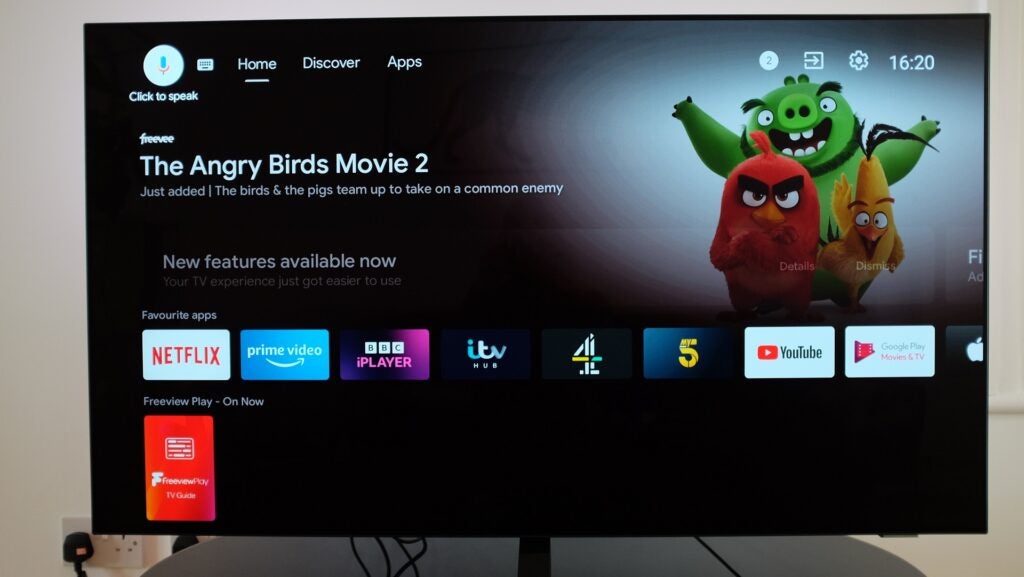
The OLED807 uses Android TV as a smart interface. That’s a good thing inasmuch as it’s filled with useful apps of all kinds, and is nicely implemented, but not such a good thing when you consider its distinct lack of customisation options and rather in-your-face presentation.
Google Assistant is built in, and there’s also a nicely sized, leather-backed remote control with which to navigate too. Philips has yet to go down the increasingly common route of shipping its TVs with two handsets, preferring to issue a single, full-function remote that feels good in the hand and is, broadly speaking, quite intuitive to use.
Quite intuitive is not, in all fairness, the first phrase that springs to mind when considering the 807’s set-up menus. Not for the first time, and almost certainly not for the last, Philips has presented the end user with an awful lot of command and set-up options with this TV – and until you’ve investigated every single one of them, you won’t know if they’re essential (or even worthwhile) or not.
If it’s out-of-the-box performance you’re after, the OLED807 may not be the TV for you, but if you’re prepared to put the hard yards in – especially when motion-control and noise-reduction are concerned – then the rewards can be significant.
Picture quality
- Brighter than previous OLED TVs
- Lovely picture performance (if you’re prepared to work for it)
- Impressive where upscaling and gaming are concerned
Philips has availed itself of LG’s new EX OLED panel for the 807 – it’s reckoned to be as much as 30% brighter as regular panels. So in theory, at least, it’s ready to solve the one significant shortcoming of OLED TV technology versus its mainstream rivals – brightness, or the lack thereof.
The sixth (and most brainy) generation of Philips’ P5 quad-core picture processor oversees picture quality here and as long as you’re prepared to do your bit in terms of set-up, it proves a very capable engine indeed. The combination of the new, brighter panel, the P5’s expertise and some Dolby Vision HDR content via Netflix proves very persuasive indeed. Kleo combines Dolby Atmos and Dolby Vision to winning effect, and as far as the OLED807 is concerned it’s the ideal content to showcase its capabilities.
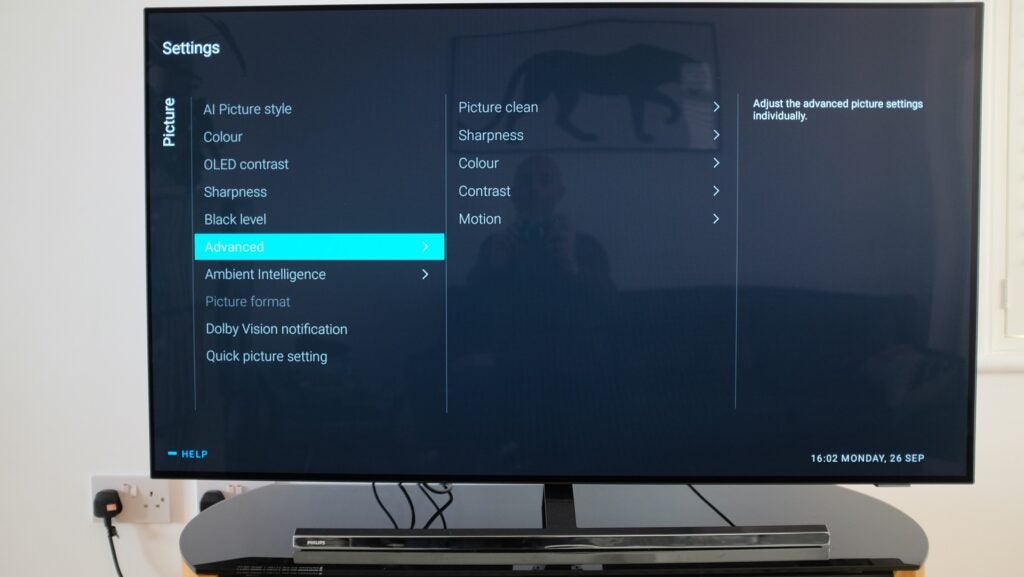
Contrasts are the most immediately impressive part of the picture performance. Those celebrated OLED black tones are deep and detailed – and they resist crushing the information out of uniformly dark areas very well too. Teamed with this new, impressively intense, ability with white tones – even if they’re tiny bright areas in a predominantly black scene – contrasts are wide, stable and information-rich at every turn.
The rest of the colour palette is lifelike and convincing – and, to be absolutely blunt, much better judged and much less aggressive than we’ve become used to from Philips. There’s still intensity of tone when needs be, of course, but when it’s describing skin-tones (in particular) the 55OLED807 is more lifelike and convincing than the model it replaces. And this is true even if you’re using one of the more, um, vivid picture presets.
On-screen motion is smoothly and confidently rendered (once you’ve hit upon your preferred in-menu formula, of course) – and it manages to dispense with that rather over-processed, video-like picture quality that was sometimes the trade-off in the past. Edges stay crisp rather than becoming smeary, and picture noise stays very low even if the processing engine is working its metaphorical socks off.
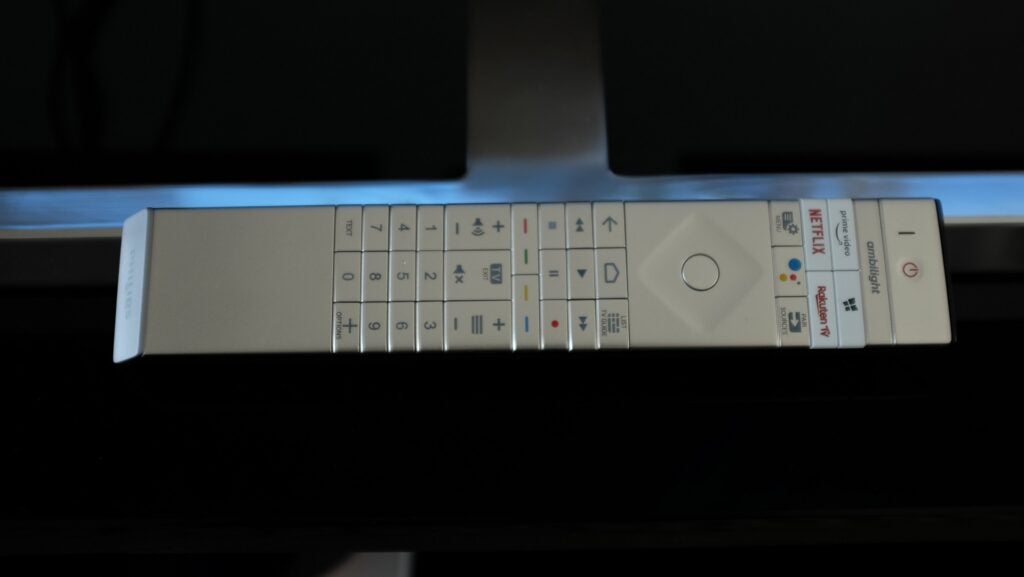
Switching to some less friendly content doesn’t faze the 55OLED807, either. It’s a very adept upscaler of 1080p content, and even if you decide to put some properly vintage 720p stuff on it retains most of its composure. Detail levels fall away, of course, and there’s a mild-but-definite coarsening over every aspect of imaging-making – but edges stay commendably consistent and on-screen motion remains (mostly) believable.
The 55OLED807 proves a very capable gaming monitor, too. With a PlayStation 5 attached to one of the HDMI 2.1 inputs and HDR Game mode selected, all those lovely black levels, intense white tones and wide-ranging colours are to the fore – and the Philips shows a very convincing way with lighting effects, too. The refresh rate is perfectly acceptable for all but the most dedicated gamers, and the immersive nature of the Ambilight feature is perhaps more apparent here than it is with live-action content.
Sound quality
- 70-watt audio system
- Reasonably detailed and distinct
- Slightly uncertain treble reproduction
As with the product it replaces, the 55OLED807 has a 2.1-channel audio system – some of which is visible on the TV’s rear panel. There’s an all-in total of 70 watts of power, driving four high/mid drivers and a subwoofer.
By the prevailing standards of affordable(ish) televisions, the Philips doesn’t sound too bad at all. It can gesture towards low-frequency presence, but doesn’t lose its grip on bass sounds unless the action gets very explosive and/or you ramp the volume right up.
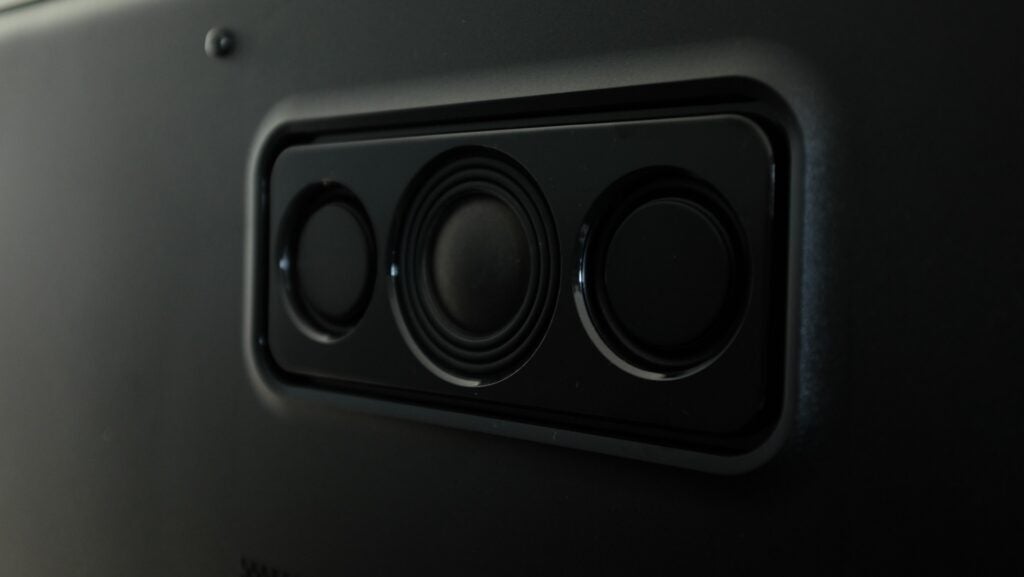
The midrange is distinct and detailed, and there’s decent substance to the top end too. The 807 can make sense of Dolby Atmos soundtracks, but it’s very much a stereo device – even if it’s capable of a quite wide spread of sound.
The top of the frequency range is just a little problematic in tonal terms – it’s not so much hard as just a touch phase-y. So treble sounds can seem a little less positive and a little more vague than everything that’s happening beneath them.
Latest deals
Should you buy it?
You want the strike the best size/OLED images balance possible This sort of money can’t currently buy you a more capable OLED TV where picture performance is concerned
You’re expecting all the hard work to be done for you Set some time aside to thoroughly investigate the OLED807’s set-up menus if you want to know what it’s capable of
Final Thoughts
There was a time when Philips TVs frustrated as much as they captivated – setting them up took forever, and sometimes you couldn’t rid them of a sort of super-accurate relentlessness of images. Those days, safe to say, are gone – the 55OLED807 frustrates not at all and captivates almost all the time
How we test
We test every televisions we review thoroughly over an extended period of time. We use industry standard tests to compare features properly. We’ll always tell you what we find. We never, ever, accept money to review a product.
Find out more about how we test in our ethics policy.
Tested for more than a week
Tested with real world use
FAQs
You can get the OLED807 TV in 48, 55-, 65 and 77-inch sizes.
Full specs
Sustainability
Trusted Reviews’ holds the fact that global warming is not a myth as a core value and will continuously endeavour to help protect our planet from harm in its business practices.
As part of this mission, whenever we review a product we send the company a series of questions to help us gauge and make transparent the impact the device has on the environment.
We currently haven’t received answers to the questions on this product, but will update this page the moment we do. You can see a detailed breakdown of the questions we ask and why in our sustainability info page.








